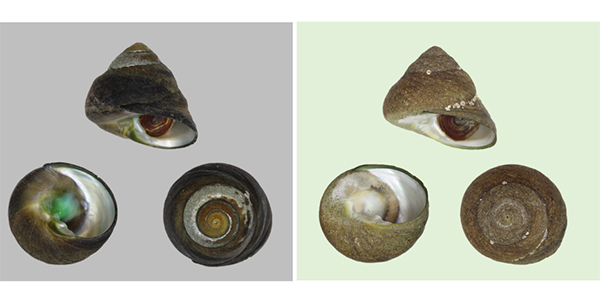Recognizing species is important for understanding regional biodiversity and for environmental conservation. However, taxonomic identity is sometimes obscure even with the organisms that are closest to human life.
Researchers from Tohoku University and Okayama University have found and described a new species from a very familiar and edible group of the marine snail genus Tegula. This new species has been named Tegula kusairo Yamazaki, Hirano, Chiba & Fukuda, 2020.
Tegula xanthostigma is a common and edible marine snail species with two shell colour forms: black and brown-green. Consistently, the two shell forms have been treated as intraspecific variations of a single nominal species, T. xanthostigma. However, recent molecular phylogenetic and ecological studies have demonstrated that these two forms are genetically distinct and differ in habitat usage patterns. It is thus reasonable to separate them into two different species.
To do so, researchers performed morphological analysis and assessed literature from the 19th century onwards. While the black shell corresponds to T. xanthostigma, the brown-green shell, which has never had a valid scientific name, is now considered its own species: T. kusairo.

The differences between the two species are:
T. xanthostigma’s shell surface is black while the underside is bright green. The species is found on rocky shores facing the open sea. The distribution area is from the Japanese mainland to the northern part of Vietnam.
T. kusairo shell surface is brown-green while the underside is pale yellow or white. The shell is smaller than T. xanthostigma. This species mainly inhabits sheltered coastal environments, specifically muddy gravel bottoms in the upper to middle intertidal zones.
Its distribution is limited to Japanese sheltered coastal areas such as the Seto Inland Sea, Ōmura Bay in Nagasaki Prefecture, Kinkō Bay in Kagoshima Prefecture and the southern part of South Korea.
Familiar marine snail groups caught as food still contain undescribed species. In 2017, the turban shell species, which is well known by the Japanese, gained a new classification (Turbo sazae Fukuda, 2017), and this case is similar to the current study. In short, people did not know what species they were eating.
“Our results highlight the difficulty of identifying and classifying marine molluscs,” said Daishi Yamazaki, co-author of the study. “It also showed that integrating morphology, ecology, and genetics provides a powerful method to detect species’ boundaries.”
In the future, the researchers hope to establish a classification system of marine snail groups, including the Tegula genus, and clarify the process of species diversification in East Asia.
- Publication Details:
Title: A new replacement name for Chlorostoma lischkei Pilsbry, 1889 (not of Tapparone-Canefri, 1874) (Vetigastropoda: Trochida: Tegulidae)
Authors: Daishi Yamazaki, Takahiro Hirano, Satoshi Chiba, and Hiroshi Fukuda
Journal: Molluscan Research
DOI: 10.1080/13235818.2020.1831716



